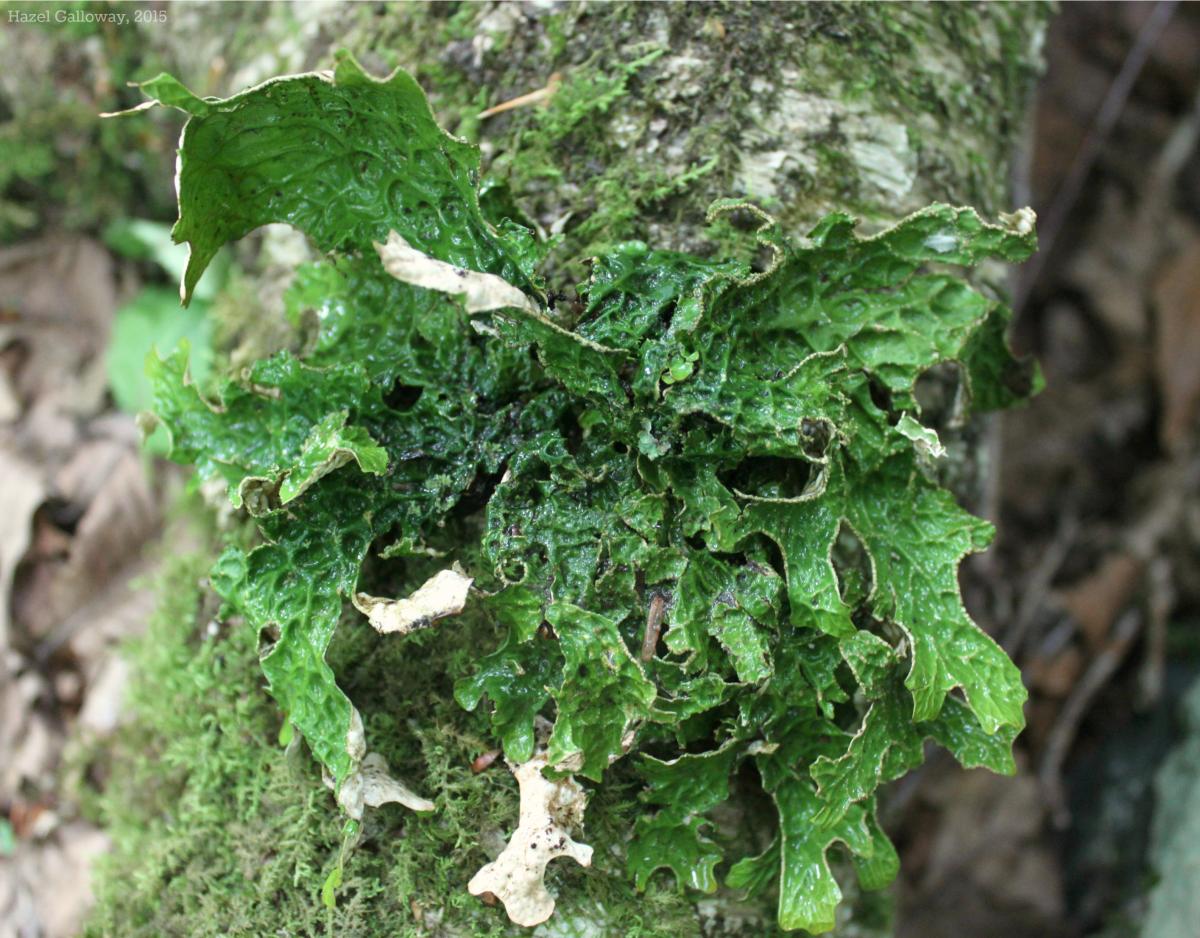 As with all lichens, the Latin name L. pulmonaria refers to the fungal species which forms the structural framework of the “organism.” Although relationships between fungus and algae vary from symbiotic to parasitic among lichens, neither species can form anything resembling a lichen—or, often, survive—in isolation from its partner. The photobiont (a portmanteau of “photosynthetic” and “symbiont”) species that provides energy for this lichen is a green algae, Dictyochloroposis. In addition to the alga, which is responsible for lungwort’s vivid green color, blue-green cyanobacteria are also harbored inside the lichen. The cyanobacteria fix nitrogen from the air, meaning that decomposing lungwort are an important source of soil nitrogen in their ecosystems.
As with all lichens, the Latin name L. pulmonaria refers to the fungal species which forms the structural framework of the “organism.” Although relationships between fungus and algae vary from symbiotic to parasitic among lichens, neither species can form anything resembling a lichen—or, often, survive—in isolation from its partner. The photobiont (a portmanteau of “photosynthetic” and “symbiont”) species that provides energy for this lichen is a green algae, Dictyochloroposis. In addition to the alga, which is responsible for lungwort’s vivid green color, blue-green cyanobacteria are also harbored inside the lichen. The cyanobacteria fix nitrogen from the air, meaning that decomposing lungwort are an important source of soil nitrogen in their ecosystems.
The presence of a second partner species means that this single “organism” encompasses three distinct species, representing both prokaryotes and eukaryotes. Conflicting theories exist about the evolution of these relationships in lichen; one hypothesis suggests a single origin of “lichenization,” whereas another indicates many different origins.
When wet, the photosynthesizing algae in the thallus (main, lobed tissue) cause the lichen to be bright green; when dry, the color recedes to a dull grey-green. The lettuce-like lobes of the thallus are 8-30 mm wide and up to 7 cm long. The strongly ridged and pitted lichen surface is said to resemble lung tissue, which gives rise to both its common and Latin names. Because of its apparent connection to the lungs, L. pulmonaria was long used to treat tuberculosis, and in some parts of the world to treat other lung diseases, asthma, or hemorrhages.
The fungal partner in most lichens reproduces sexually by means of apothecia, specialized spore-producing structures on the thallus. Lungwort more commonly reproduce via an asexual process analogous to budding in plants. Lungwort individuals produce granules called soredia at the surface of the thallus containing both fungus and algae; these break off and establish themselves as new individuals. A study in Switzerland found no correlation between population size and genetic diversity, although genetic diversity was linked to the proportion of individuals reproducing sexually.
Lungwort grows on trees, mossy rocks, and rotting wood, and is often found in areas home to both hardwoods and conifers. Like other members of the Lobaria genus, it is highly sensitive to pollution and disturbance and its presence is a good indicator of rich, old growth forests. Research done in Estonia indicates that the species prefers habitats where the average age of trees is over 100, although it can also thrive in younger stands with similar structures. This sample was found in Pond Drain, one of the few areas on the mountain that was never logged. Mountain Lake lies on the southernmost edge of L. pulmonaria’s range, which extends north as far as Newfoundland. It also occurs on the northwest coast from central California through Alaska, but is absent from the center of the country.
Hazel Galloway
Sources:
- Brodo, Irwin M. Lichens of North America. New Haven: Yale University Press, 2001.
- Zoller, S., F. Lutzoni, and C. Scheidegger. "Genetic Variation within and among Populations of the Threatened Lichen Lobaria Pulmonaria in Switzerland and Implications for Its Conservation." Molecular Ecology 8.12 (1999): 2049-59.
- www.fs.fed.us/wildflowers/plant-of-the-week/lobaria_pulmonaria.shtml
- www.ut.ee/ial5/fce/fce46pdf/fce46_juriado.pdf



